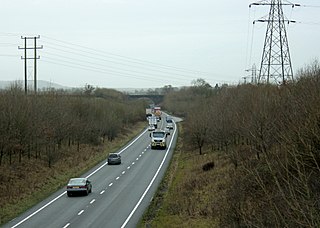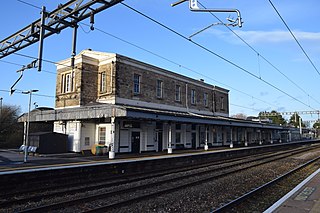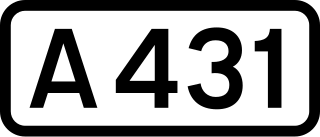
Wiltshire is a historic and ceremonial county in South West England with an area of 3,485 km2. It is landlocked and borders the counties of Dorset to the southwest, Somerset to the west, Hampshire to the southeast, Gloucestershire to the north, Oxfordshire to the northeast and Berkshire to the east. The county town was originally Wilton, after which the county is named, but Wiltshire Council is now based in the county town of Trowbridge. Within the county's boundary are two unitary authority areas, Wiltshire and Swindon, governed respectively by Wiltshire Council and Swindon Borough Council.

The A40 is a trunk road which runs between London and Goodwick (Fishguard), Wales, and officially called The London to Fishguard Trunk Road (A40) in all legal documents and Acts. Much of its length within England has been superseded by motorways, such as the M40, and has lost its trunk road status, though it retains it west of Gloucester, including its length within Wales. It is approximately 260 miles (420 km) long. The eastern section from Denham, Buckinghamshire to Wheatley, Oxfordshire is better served by the M40 and its former function of linking London with Cheltenham and Gloucester has been taken by the M4, A419 and A417 via Swindon.

The A4 is a major road in England from Central London to Avonmouth via Heathrow Airport, Reading, Bath and Bristol. It is historically known as the Bath Road with newer sections including the Great West Road and Portway. The road was once the main route from London to Bath, Bristol and the west of England and formed, after the A40, the second main western artery from London.

The A361 is an A class road in southern England, which at 195 miles (314 km) is the longest three-digit A road in the UK.

The Great Western Main Line (GWML) is a main line railway in England that runs westwards from London Paddington to Bristol Temple Meads. It connects to other main lines such as those from Reading to Penzance and Swindon to Swansea. Opened in 1841, it was the original route of the first Great Western Railway which was merged into the Western Region of British Railways in 1948. It is now a part of the national rail system managed by Network Rail with the majority of passenger services provided by the current Great Western Railway franchise.

The A350 is a north–south primary route in southern England, that runs from the M4 motorway in Wiltshire to Poole in Dorset.

Botley is a village in the civil parish of North Hinksey in the ceremonial county of Oxfordshire, just west of the Oxford city boundary. Historically part of Berkshire, it stands on the Seacourt Stream, a stream running off the River Thames. The intersection of the A34 and A420 is to the village's north.

The A417 is a main road in England running from Streatley, Berkshire to Hope under Dinmore, Herefordshire. It is best known for its section between Cirencester and Gloucester where it has primary status and forms part of the link between the major settlements of Swindon and Gloucester.

Didcot Parkway is a railway station serving the town of Didcot in Oxfordshire, England. The station was opened as Didcot on 12 June 1844 and renamed Didcot Parkway on 29 July 1985 by British Rail to reflect its role as a park and ride railhead. It is 53 miles 10 chains down the line from London Paddington and is situated between Cholsey to the east and Swindon to the west.

Wantage is a constituency in Oxfordshire represented in the House of Commons of the Parliament of the United Kingdom by Conservative MP David Johnston.

Swindon railway station is on the Great Western Main Line in South West England, serving the town of Swindon, Wiltshire. It is 77 miles 23 chains down the line from the zero point at London Paddington and is situated between Didcot Parkway and Chippenham on the main line. It is managed by Great Western Railway, which also operates all the trains.

Bourton is a village and civil parish in the Vale of White Horse about 4 miles (6.4 km) southeast of Highworth in neighbouring Wiltshire. The western boundary of the parish is a stream that also forms the county boundary. Bourton was part of the parish of Shrivenham until 1867. Bourton was part of Berkshire until the 1974 local government boundary changes transferred the Vale of White Horse to Oxfordshire. The 2011 Census recorded the parish population as 326.
The Oxford Ring Road circles the city of Oxford, England. It is a dual carriageway ring road for most of its length apart from a short section between Woodstock Road and Banbury Road in the north of the city. The severe restrictions on traffic in Oxford city centre mean that it is the only practical way for long-distance traffic to get past Oxford, especially as there are few road bridges over the rivers Isis and Cherwell. Five Park and Rides are close to the ring road.
Cumnor Hill is a hill in the civil parish of Cumnor, to the west of the city of Oxford, in the English county of Oxfordshire. In 1974 it was transferred from Berkshire. It is also the name of the ribbon development between the original Cumnor village and Botley, outside the ring road on the outskirts of Oxford.

The A338 is a major primary route in southern England, that runs from the junction with the A35 at Poole in Dorset to the junction with the A420 at Besselsleigh in Oxfordshire, a distance of 84 miles (135 km).

Southmoor is a village in the civil parish of Kingston Bagpuize with Southmoor, about 6 miles (9.7 km) west of Abingdon, Oxfordshire. Historically part of Berkshire, the 1974 boundary changes transferred local government to Oxfordshire. Southmoor village is just south of the A420 between Oxford and Swindon.

The A431 is an A road running from Bristol to Bath in England. It runs parallel to, and about 3 miles (4.8 km) to the north of, the A4, the principal route between Bristol and Bath on the south side of the River Avon.
















